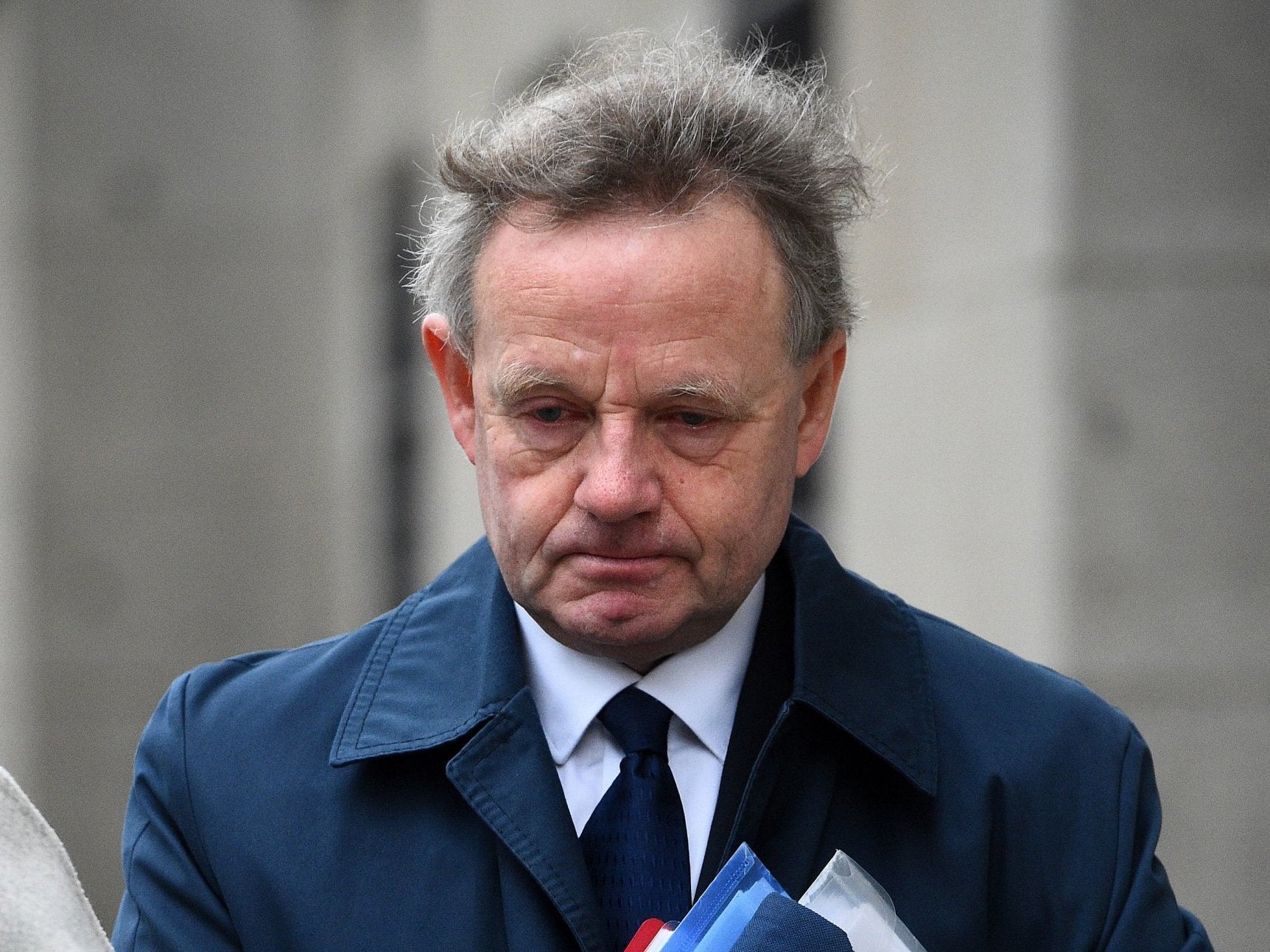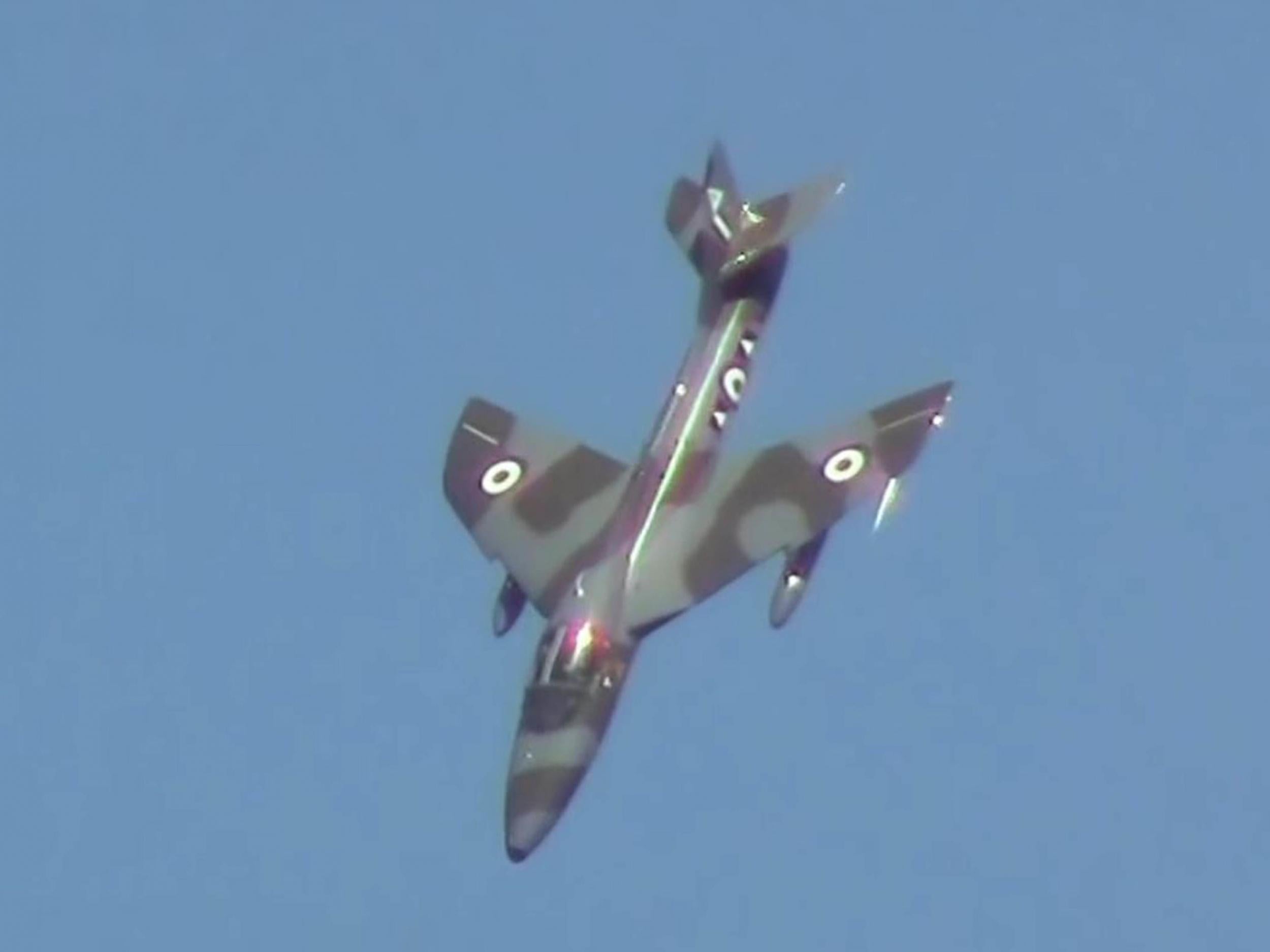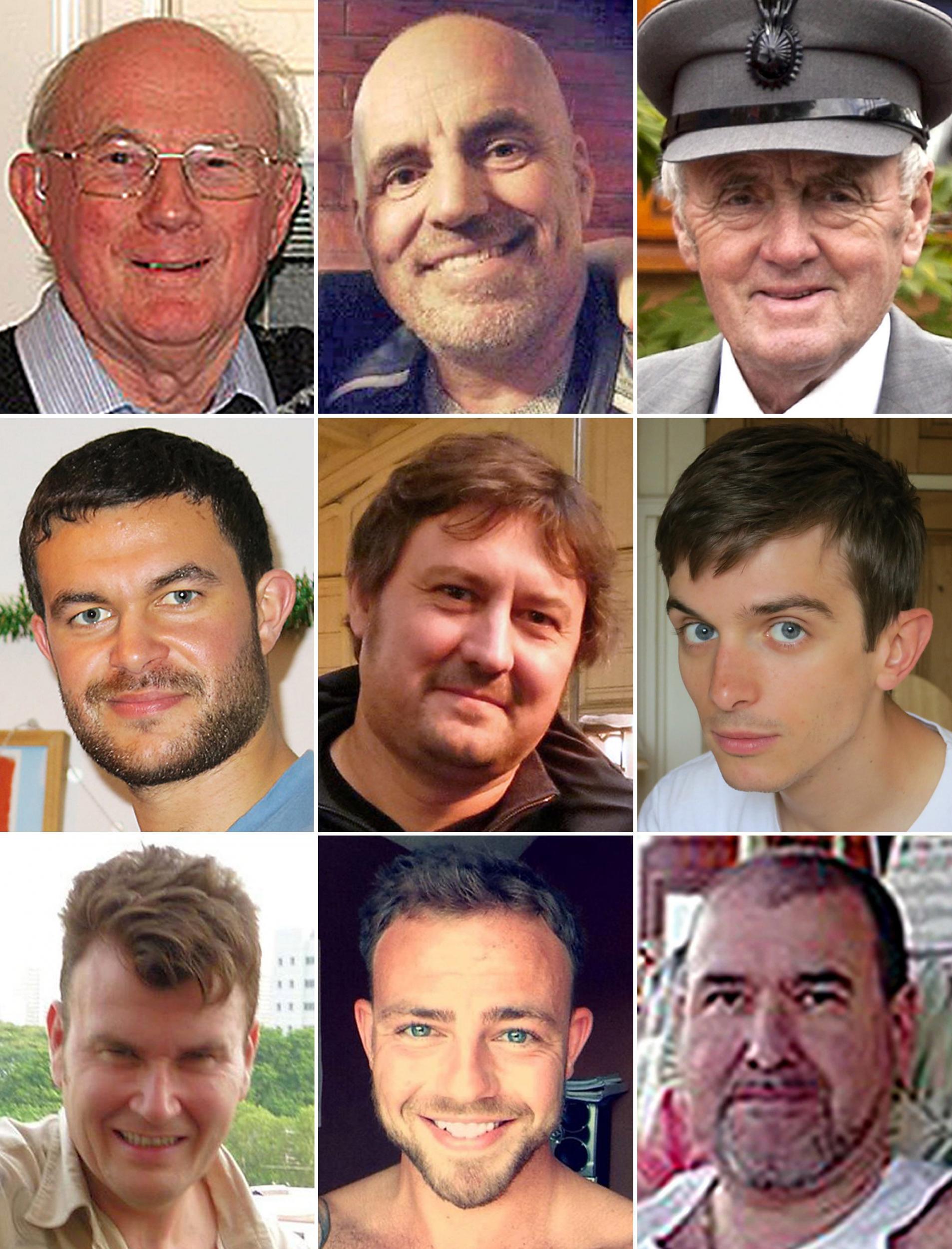Shoreham airshow pilot who crashed plane doing ‘bent loop’ trick while 1,000ft too low, killing 11, cleared of gross negligence
After bereaved relatives gasp and weep as he is cleared, ex-BA captain, who said he had suffered ‘cognitive impairment’ before the crash, issues statement saying he is ‘truly sorry for the part I played in the deaths’
An airshow pilot has been cleared of gross negligence manslaughter despite a jury hearing how his jet crashed in a fireball on a busy dual carriageway, killing 11 people.
Bereaved relatives gasped and wept as Andy Hill was found not guilty despite the Old Bailey hearing he had been too slow and probably as much as 1,000ft (305m) too low at the top of a “bent loop” manoeuvre at the Shoreham airshow in Sussex on 22 August 2015.
After walking free from court, Mr Hill, whose defence had argued his flying had been affected by “cognitive impairment” just before the crash, read the names of all 11 men who died, and said: “I am truly sorry for the part I played in their deaths. It is them I will remember for the rest of my life.”
But Sue and Phil Grimstone, whose 23-year-old son Matthew was among the dead, said they were “devastated” by the acquittal, adding: “There seems to be no justice for our son Matthew and all 11 men who died in such tragic circumstances.”
The Grimstones, who in the immediate aftermath of the crash had called for displays to be over the sea, also questioned whether UK airshows were too risky to continue in their current form.
They said: “Why are we allowing any form of aerobatics to be performed when there is now doubt concerning any pilot’s ability to avoid becoming cognitively impaired from the normal G forces that will be experienced during an aerobatic display?
“Matthew had no interest in airshows, he could not have cared less. Knowing he died because an aircraft was being flown for fun, for the entertainment of others, makes it even harder to bear.”
Outside court, police said they respected the jury verdict but Leslye Polito, mother of the youngest crash victim, Daniele Polito, 23, said she felt “disappointed, very upset and primarily let down by the justice system”.
“The whole fact it was avoidable,” she said, “was the hardest bit to consider and process. It’s still the hardest bit.”
The court had heard that instead of using a relatively simple escape manoeuvre, Mr Hill, a former RAF Harrier pilot, had committed the aviator’s “cardinal sin” of trying to complete the loop.
His 1950s-era Hawker Hunter jet smashed into the busy A27 just north of the airfield and burst into flames.
The court heard how for the 11 fatalities, death came “instantaneously” from “body fragmentation”, “blunt force trauma” or “burns and smoke inhalation”.
Mr Grimstone, described by his family as “the kindest person you could ever meet”, died alongside his teammate Jacob Schilt, also 23, as they drove to play in a football match.
Wedding chauffeur Maurice Abrahams, 76, driving a Daimler along the A27 on his way to collect a bride in Worthing, was hailed a hero after the crash.
It was reported that his kindness in letting a family’s car overtake him had allowed them to drive beyond the area where the plane came down.
“They say angels come in many forms,” the father of the family had written. “Maurice was ours on that tragic day.”
It was Britain’s worst airshow disaster since 31 people died in the Farnborough tragedy of 1952.
Yet Mr Hill, 54, of Sandon, Buntingford, Hertfordshire – a British Airways captain at the time of the crash – was miraculously thrown clear of the burning plane and survived.
During a trial in which harrowing footage of the crash was shown to the jury, he denied 11 counts of gross negligence manslaughter.
Tom Kark QC, prosecuting, said the vintage jet had been in perfect flying condition and the crash happened “purely because of pilot error”.
“It was Mr Hill’s serious negligence that led directly to the loss of 11 lives,” said Mr Kark.
The prosecutor added that despite normally being a “careful and competent” pilot, there had been previous occasions when Mr Hill had taken “risks”, played “fast and loose” with regulations, and shown a “more cavalier attitude to safety than was appropriate”.
But a succession of prosecution witnesses seemed to lend credence to the defence claim that the only rational explanation for Mr Hill’s appalling flying was that he had suffered some form of “cognitive impairment”, possibly brought on by G-forces experienced while manoeuvring the jet.
The court also heard that, as he lay injured on the ground, Mr Hill had told a paramedic treating him he had “at some point blacked out in the air”.
Derek Davis, chair of the airshow’s flight control committee, said the jet “just continued waffling down” as if the pilot was “doing nothing” until a last-second violent pitch up suggested that at 100ft “there is probably some recovery, his eyes probably opened, and instinctively [he reacted]”.
He agreed with Karim Khalil QC, defending, that until the last-minute evasion the plane didn’t seem to be controlled at all, adding: “There was something wrong with either the aircraft or the pilot.”
Other witnesses described Mr Hill as an expert flyer, “safety conscious”, “probably the most diligent member” of a display team, and the opposite of cavalier.

The court heard that at the 2014 Southport airshow Mr Hill had been the subject of a rare “stop, stop, stop” order commanding him to end his display immediately because he had flown dangerously close to the crowd.
But the court also heard that after Mr Hill was debriefed, no Civil Aviation Authority (CAA) action was taken against him and the airshow organisers had been happy to let him display again the following day.
The prosecution had to withdraw a claim he had flown too low over the M11 during a practice display at Duxford after the defence produced a copy of the airfield rules to show he had been at a permissible altitude.
Appearing for the defence, aviation safety expert Dr Stephen Jarvis detailed a “cascade” of 12 errors in just 23 seconds during the botched loop, and said the only possible explanation for them was cognitive impairment.
He said he didn’t believe Mr Hill had simply been guilty of “extremely bad piloting”.
“I can’t really accept that,” Dr Jarvis told the court. “Mr Hill was a very experienced pilot and it just doesn’t seem credible to me.”
When Mr Hill appeared in the witness box, it was the first time he had spoken publicly about the disaster.
He now has no memory of the crash or the moments leading up to it.
In court, when video of the disaster was played, he ducked down in the dock to avoid seeing it. Mr Khalil explained his client had been advised to avoid watching the final moments of any footage because of “concerns of what it may trigger” for him.
When Mr Khalil asked what he felt, knowing the devastation the crash had caused, Mr Hill told the court it was a “dominant thought” in his life.
“Probably most of the last three years have been spent trying on Earth to resolve what happened,” he said. “It caused a dreadful tragedy to a lot of people.
“I was the pilot, I was in charge of the aircraft.”

But he maintained he was “probably one of the last people” who could be described as “cavalier”.
He told the court the way the jet was flown during the botched stunt makes “no sense” and he “could not understand it”, adding: “It doesn’t seem what I would likely do. It’s not particularly well flown. It’s not being controlled properly.”
In his summing up, Mr Justice Edis, the judge, advised the jury that “what happened is pretty clear. Why it happened is really what the case is about”.
After the verdict was delivered, following seven hours and seven minutes of deliberation, the judge turned to the relatives and told them: “I am enormously impressed and grateful for the very dignified way in which you have all behaved during what must have been a very, very difficult time.
“I can see you are upset, and you are absolutely entitled to be, but despite being upset you have behaved in a way which does you credit.”
Outside court, Detective Inspector Jon Fanner, who led the investigation, paid tribute to the relatives’ dignity and said it was “clearly appropriate” that Mr Hill had been brought to trial, although police respected the jury’s decision. He added: “We have sought to find answers for the families and friends of those who died, and I hope this trial has gone some way towards doing that.”
But the jurors’ not guilty verdict seems to leave the grieving families with unresolved questions about why their loved ones died.

Sarah Stewart, an aviation specialist at Stewarts, the law firm representing most of the bereaved relatives, called for a wider investigation to prevent future tragedies.
She said: “The families want answers, and a verdict will go some way towards that but it is only one part of the jigsaw.”
“The bereaved families,” she added, “have had to painfully relive the circumstances of their loved ones’ deaths again and again.”
The result of a trial that lasted nearly two months may also leave unresolved a number of questions about UK airshows, and the modern public’s appetite for the risks associated with them.
The CAA responded to Shoreham by banning vintage jets from high-energy aerobatics over land, but the authority has faced calls to go further, including from relatives of those who died.
Soon after the disaster, Sue Grimstone said: “Airshows should be over the sea. It should never have been over that road.”
One former display pilot told The Independent that before Shoreham there had been a degree of complacency about the UK’s airshow, for those on the ground, safety record that had made watching displays one of the safest spectator activities available.
He said some in aviation had failed to recognise the world had moved on since the 1952 Farnborough disaster, which occurred when national servicemen were fighting in Korea, seven years after the end the Second World War.
“We now live in a world protected by cotton wool,” the ex-display pilot said, “because – quite rightly – we are protected by health and safety. What is the public’s appetite for risk?
“What are the hazards when areas around these airfields are getting more built up?”
Such questions, however, have also been accompanied by suggestions that the horrifically spectacular nature of the crash distorted the public’s understanding of risk.
Aviation consultant and airshow commentator Sean Maffett told The Independent: “You do need a balance of risks to let normal life go on. If you said you can’t have a display within half a mile of a main road, I suspect that would stop an awful lot of flying displays.”
And some aviation enthusiasts seem to have been deterred from attending shows because of the post-Shoreham safety regulations.
The jury’s verdict came two days after the Farnborough International Airshow scrapped its public display weekend, saying the ban on vintage jets doing aerobatics over land had confined a number of displays to mere flypasts, limiting spectator excitement.